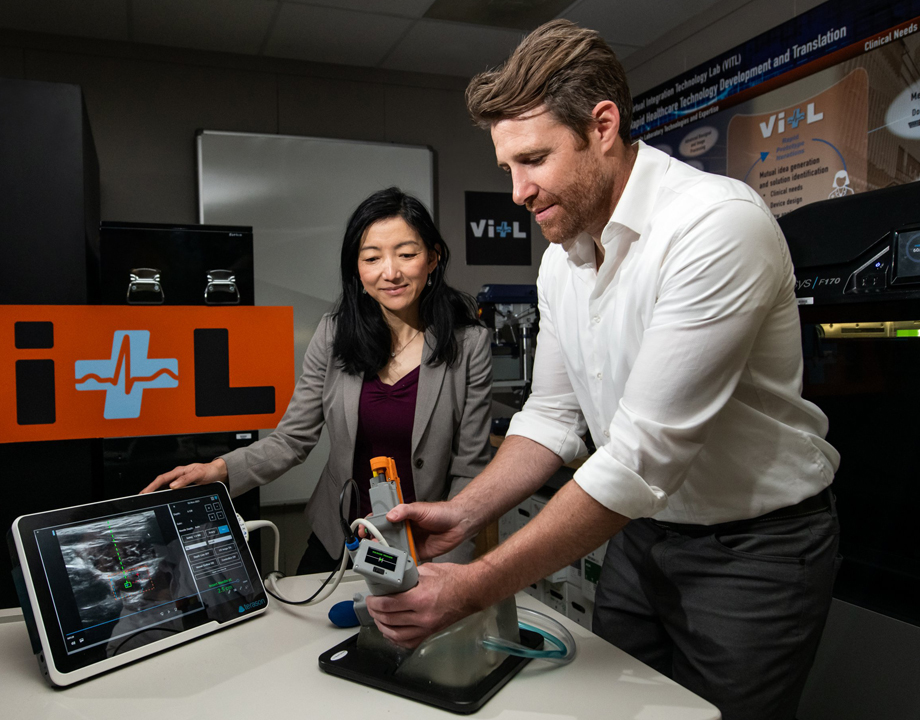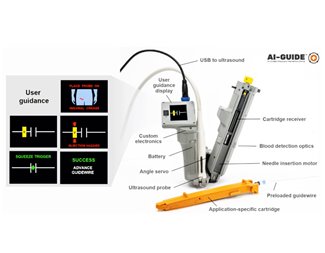Handheld Device May Help Stop Fatal Blood Loss
Handheld Device May Help Stop Fatal Blood Loss


MIT researchers develop device to bring high-tech medical care to the field. Photo: MIT Lincoln Lab
There is a great need for an easy-to-use device that could help save lives from fatal blood loss in emergency settings, and a team at the MIT Lincoln Laboratory (MIT LL) and Massachusetts General Hospital has developed one that can be learned in just a few minutes.
The device, called the Artificial Intelligence-Guided Ultrasound Intervention DEvice (AI-GUIDE), is a portable handheld mechanism that detects a blood vessel and inserts a needle, followed by a guidewire. It is then up to the user to guide a dilator and then a catheter over the guidewire into the vessel to begin supplying fluids to a patient, or to perform other interventions. The U.S. Department of Defense has been partnering with the team on this project for use in military settings.
“We want to be ready for future conflicts where casualties may not be able to be evacuated quickly to a hospital, and so we will need to manage casualties in the field for a prolonged period of time,” explained Laura Brattain, the project’s co-lead from the Human Health and Performance Systems Group at MIT LL. “In order to support that mission we need to bring medical care that is usually available in large hospitals to the field, and vascular access is one of the procedures that would enable a number of downstream life-saving interventions.”
The DOD requested that the system be as easy to use as possible for less trained medical personnel, but also lightweight and compact. Currently, there isn’t anything on the market like AI-GUIDE.
“It was all about driving toward a really functional and practical device that keeps in mind the user first and the chaotic environment that they're going to be operating in,” said Matt Johnson, the project’s hardware lead.
For these reasons, the first step was creating an interface for a device that would be very easy to interpret. The display looks very much like the arcade game Pong, and it’s as simple as holding the device over the femoral region and aligning the dot with the center of the target. The display is also tunable to provide different levels of detail depending on the levels of medical expertise of the intended end users. But whatever the setting, such simplicity could only be achieved with a highly intuitive AI system.
“We developed data collection workflows that captured the complex movements of ultrasound that the experts use,” said Lars Gjesteby, the team’s AI lead. “We collected tens of thousands of ultrasound images, including the femoral artery and vein, and we trained an algorithm to be able to recognize these structures and automatically segment and track those vessels in real time.”
Take the Quiz: Medical Device Evolution
But locating the blood vessel isn’t the only challenge a medical professional will face. Inserting the needle when there has been extreme blood loss adds an extra layer of complexity. Think about how it is more difficult to puncture a balloon that is partially deflated: The blood vessel tents, making it more likely that the needle will not penetrate the vessel wall. AI-GUIDE reduces the likelihood of this happening by inserting the needle to a series of waypoints that include a position that overshoots the computed vessel centroid but does not pass through the posterior vessel wall.
In addition, AI-GUIDE automatically confirms the needle was successfully inserted with a blood-flashback system. As the needle penetrates the area it creates suction, which pulls blood into a syringe fitted on the backend of the needle. The device is equipped with an LED and detector, which indicate when the syringe fills with blood because the light is optically blocked, creating a shuttering effect much like a garage door sensor might. This confirms that the needle is inside the vessel properly and notifies the user to perform the next steps of vascular access.
One of the technical challenges in developing the system was dealing with kickback from inserting a needle. When a needle is inserted at a high speed it could cause a kickback that would jostle the system and the overall placement of the needle. Josh Werblin, hardware engineer, said this ended up being more of a design consideration because with two hands, a user could steady the device and prevent the kickback. So the team experimented with different hand positions and needle speeds to find the right combination that wouldn’t destabilize the system or add extra weight and dimension to the overall design.
“With any changes like this, we really have to think creatively about how to keep the device small and lightweight,” Werblin said. “We changed the focus of grip to the user’s right hand, which is in line with the needle, so now the force of the needle is coming directly into their hand and they're able to hold it much more steadily.”
Watch the Video: Bioinspired Breakthroughs Transform Medical Devices
As of right now, the device has been tested in a clinical model on the femoral artery and vein on the inner thigh. The team is working to adapt the technology to other major access points in the body.
“We're gradually adding more and more pieces to the system to make it more intuitive for people with varying medical expertise,” Brattain said. “The more we can automate the vascular access process, the more useful it will become.”
A start-up company has already licensed an option for the AI-GUIDE intellectual property, bringing it one step closer to transition out of MIT LL. For now, the team continues to develop AI-enabled ultrasound solutions, including one that would detect disease in the thoracic region, and one that could detect musculoskeletal injuries.
Cassandra Martindell writes about technology and science in Groveport, Ohio.
The device, called the Artificial Intelligence-Guided Ultrasound Intervention DEvice (AI-GUIDE), is a portable handheld mechanism that detects a blood vessel and inserts a needle, followed by a guidewire. It is then up to the user to guide a dilator and then a catheter over the guidewire into the vessel to begin supplying fluids to a patient, or to perform other interventions. The U.S. Department of Defense has been partnering with the team on this project for use in military settings.
“We want to be ready for future conflicts where casualties may not be able to be evacuated quickly to a hospital, and so we will need to manage casualties in the field for a prolonged period of time,” explained Laura Brattain, the project’s co-lead from the Human Health and Performance Systems Group at MIT LL. “In order to support that mission we need to bring medical care that is usually available in large hospitals to the field, and vascular access is one of the procedures that would enable a number of downstream life-saving interventions.”
The DOD requested that the system be as easy to use as possible for less trained medical personnel, but also lightweight and compact. Currently, there isn’t anything on the market like AI-GUIDE.
“It was all about driving toward a really functional and practical device that keeps in mind the user first and the chaotic environment that they're going to be operating in,” said Matt Johnson, the project’s hardware lead.
For these reasons, the first step was creating an interface for a device that would be very easy to interpret. The display looks very much like the arcade game Pong, and it’s as simple as holding the device over the femoral region and aligning the dot with the center of the target. The display is also tunable to provide different levels of detail depending on the levels of medical expertise of the intended end users. But whatever the setting, such simplicity could only be achieved with a highly intuitive AI system.
“We developed data collection workflows that captured the complex movements of ultrasound that the experts use,” said Lars Gjesteby, the team’s AI lead. “We collected tens of thousands of ultrasound images, including the femoral artery and vein, and we trained an algorithm to be able to recognize these structures and automatically segment and track those vessels in real time.”
Take the Quiz: Medical Device Evolution
But locating the blood vessel isn’t the only challenge a medical professional will face. Inserting the needle when there has been extreme blood loss adds an extra layer of complexity. Think about how it is more difficult to puncture a balloon that is partially deflated: The blood vessel tents, making it more likely that the needle will not penetrate the vessel wall. AI-GUIDE reduces the likelihood of this happening by inserting the needle to a series of waypoints that include a position that overshoots the computed vessel centroid but does not pass through the posterior vessel wall.
In addition, AI-GUIDE automatically confirms the needle was successfully inserted with a blood-flashback system. As the needle penetrates the area it creates suction, which pulls blood into a syringe fitted on the backend of the needle. The device is equipped with an LED and detector, which indicate when the syringe fills with blood because the light is optically blocked, creating a shuttering effect much like a garage door sensor might. This confirms that the needle is inside the vessel properly and notifies the user to perform the next steps of vascular access.
One of the technical challenges in developing the system was dealing with kickback from inserting a needle. When a needle is inserted at a high speed it could cause a kickback that would jostle the system and the overall placement of the needle. Josh Werblin, hardware engineer, said this ended up being more of a design consideration because with two hands, a user could steady the device and prevent the kickback. So the team experimented with different hand positions and needle speeds to find the right combination that wouldn’t destabilize the system or add extra weight and dimension to the overall design.
“With any changes like this, we really have to think creatively about how to keep the device small and lightweight,” Werblin said. “We changed the focus of grip to the user’s right hand, which is in line with the needle, so now the force of the needle is coming directly into their hand and they're able to hold it much more steadily.”
Watch the Video: Bioinspired Breakthroughs Transform Medical Devices
As of right now, the device has been tested in a clinical model on the femoral artery and vein on the inner thigh. The team is working to adapt the technology to other major access points in the body.
“We're gradually adding more and more pieces to the system to make it more intuitive for people with varying medical expertise,” Brattain said. “The more we can automate the vascular access process, the more useful it will become.”
A start-up company has already licensed an option for the AI-GUIDE intellectual property, bringing it one step closer to transition out of MIT LL. For now, the team continues to develop AI-enabled ultrasound solutions, including one that would detect disease in the thoracic region, and one that could detect musculoskeletal injuries.
Cassandra Martindell writes about technology and science in Groveport, Ohio.






